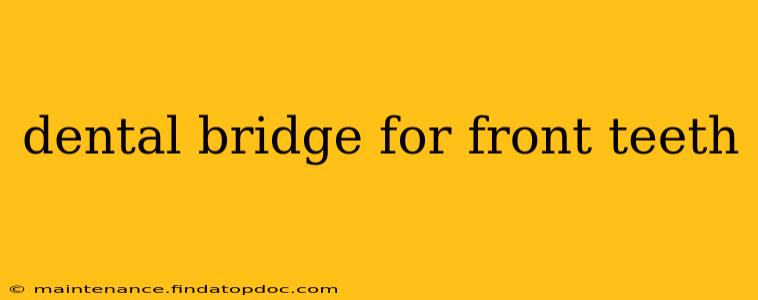Losing a front tooth can significantly impact your confidence and smile. Fortunately, a dental bridge offers a reliable and aesthetically pleasing solution to restore your smile's integrity and functionality. This comprehensive guide explores dental bridges specifically for front teeth, addressing common concerns and providing valuable insights for anyone considering this restorative procedure.
What is a Dental Bridge?
A dental bridge is a prosthetic device used to replace one or more missing teeth. It's essentially a "bridge" that "spans" the gap created by the missing tooth(teeth), hence the name. For front teeth, aesthetics are paramount, and bridges are meticulously crafted to seamlessly blend with the natural teeth. The bridge consists of artificial teeth (pontics) fused to crowns that are cemented onto the adjacent healthy teeth (abutment teeth). These abutment teeth act as anchors, supporting the bridge in place.
Types of Dental Bridges for Front Teeth
Several types of dental bridges cater to different needs and preferences. For front teeth, the focus is often on aesthetics and natural appearance:
- Traditional Bridges: This is the most common type, utilizing crowns on the abutment teeth to support the pontic(s). These bridges are highly durable and provide excellent support.
- Maryland Bridges: These bridges use metal or porcelain frameworks bonded to the back of the abutment teeth. They are less invasive than traditional bridges but may not be as strong or long-lasting. They are generally less preferred for front teeth due to potential visibility of the metal framework.
- Cantilever Bridges: These are used when only one abutment tooth is available. The pontic is attached to a crown on a single adjacent tooth. This is less common for front teeth due to potential stress on the single abutment tooth.
Choosing the appropriate type depends on factors like the number of missing teeth, the condition of adjacent teeth, and patient preferences. A consultation with a dentist is crucial for determining the best option.
How is a Dental Bridge for Front Teeth Placed?
The process typically involves several appointments:
- Examination and Planning: The dentist evaluates the oral health, examines the abutment teeth, and takes impressions for the bridge's fabrication.
- Preparation of Abutment Teeth: The abutment teeth are prepared by removing a small amount of enamel to allow for the proper fit of the crowns.
- Impression Taking: Precise impressions are taken to create accurate models for the laboratory fabrication of the bridge.
- Temporary Bridge: A temporary bridge is usually placed to protect the prepared teeth and maintain aesthetics during the fabrication process.
- Bridge Placement: Once the permanent bridge is ready, the dentist cements it onto the prepared abutment teeth.
- Follow-up Appointments: Regular checkups are essential to monitor the bridge's condition and ensure proper oral hygiene.
How Much Does a Dental Bridge for Front Teeth Cost?
The cost of a dental bridge varies depending on several factors:
- Type of bridge: Traditional bridges are generally more expensive than Maryland bridges.
- Materials: The materials used in the bridge (porcelain, gold, etc.) affect the overall cost.
- Location: Geographic location can influence the pricing of dental services.
- Dentist's fees: Each dentist has their own fee structure.
It's best to schedule a consultation with your dentist to receive a personalized cost estimate.
How Long Does a Dental Bridge Last?
With proper care and maintenance, a dental bridge can last for 10-15 years or even longer. Regular brushing, flossing, and professional cleanings are crucial for its longevity.
What are the Alternatives to a Dental Bridge for Front Teeth?
Alternatives to dental bridges include:
- Dental Implants: These offer a long-term, highly stable solution, but are generally more expensive and involve a more complex procedure.
- Removable Partial Dentures: These are a more affordable but less aesthetically pleasing and less stable option.
Are Dental Bridges Painful?
The procedure itself may involve some discomfort, but most dentists utilize local anesthesia to minimize any pain. After the procedure, some mild discomfort or soreness is possible, which can usually be managed with over-the-counter pain relievers.
How Do I Care for a Dental Bridge?
Proper oral hygiene is paramount for the longevity of a dental bridge. This involves:
- Brushing: Gentle brushing twice daily with a soft-bristled toothbrush.
- Flossing: Using floss or interdental brushes to clean around the bridge and abutment teeth.
- Regular Dental Checkups: Visiting your dentist for regular checkups and professional cleanings.
By diligently following these steps, you can significantly extend the life of your dental bridge and maintain optimal oral health.
This information is for general knowledge and does not constitute medical advice. Always consult with a qualified dental professional for personalized guidance regarding dental bridges or any other dental concerns.
